Company of Heroes is a visually stunning real-time strategy game that depicts all the violent chaos of World War II with uncommon intensity. Set during the invasion of Normandy toward the end of the war, Company of Heroes takes its cues from Saving Private Ryan, by portraying both the sheer brutality of the war as well as the humanity of its combatants. Many other recent WWII games have also drawn influence from Steven Spielberg's landmark film, but Company of Heroes is even more graphic. This and the game's highly authentic-looking presentation are its distinguishing features, and it boasts some frantic, well-designed strategic and tactical combat to match. Company of Heroes trades a wide breadth of content for an extremely detailed look at WWII-era ground combat, and its action is so fast paced that it's best suited for the reflexes of an experienced RTS player. So if you're unfazed by any of that, you'll find that this latest real-time strategy game from the developers of Homeworld and Warhammer 40,000: Dawn of War is one of the best, most dramatic and exciting examples in years.
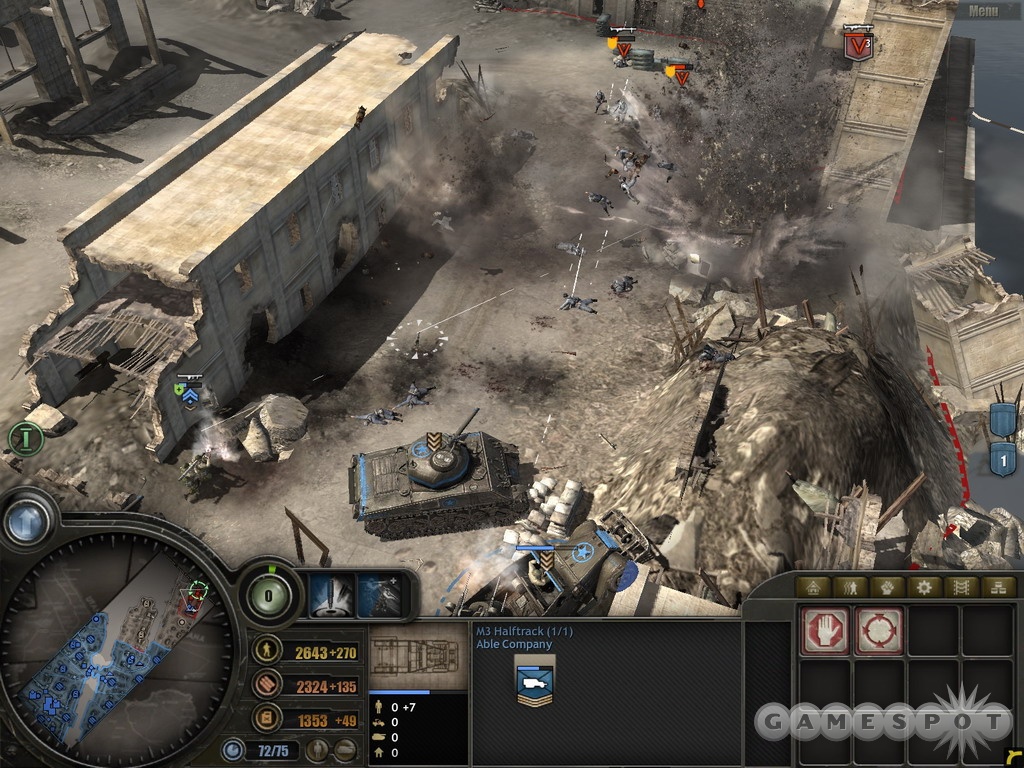
Provided you have a powerful-enough system and graphics card to fully appreciate the visuals in Company of Heroes, you'll quickly be struck by the level of detail depicted in the game. Infantry move in teams, darting from cover to cover. They may be ordered to occupy any building on the map, and you'll see them shutter the doors and take aim out the windows. Vehicles are shown to scale, so tanks and other armored vehicles look big and imposing, and, indeed, they are. Infantry seem almost helpless against tanks, and you'll hear the men screaming as tank shells explode around them, sending bodies flying, while lucky survivors dive out of the way. Yet by attacking a tank's vulnerable sides and rear armor with explosives, it's possible to turn the tables on these lumbering threats...turning one of the most basic confrontations in Company of Heroes into a thrilling cat-and-mouse game, much more than a typical clash between a couple of RTS units. What's more, the battlefields themselves have at least as much character to them as the various infantry squads and vehicles as your disposal. The quaint French towns that are the set pieces of many of the game's skirmishes truly look as if a war was waged there once the battle is done, since buildings will catch fire and collapse, telephone lines will topple, blackened craters will appear in the wake of artillery blasts, and more. These changes aren't just cosmetic, either. Those blast craters provide cover for your infantry, while the ruined husks of blown-up tanks might interfere with a machine gunner's line of fire.
The game focuses on the Allies' invasion of German-occupied Normandy in 1944, specifically on close-quarters skirmishes between infantry and armor. Company of Heroes presents a number of novel twists to real-time strategy conventions, but at heart this game works like other RTS games do, by putting you in charge of base construction, resource gathering, and tactical command of various military forces in an effort to defeat the opposition. The game includes a good-sized single-player campaign spanning more than a dozen missions, in which Able Company lands on Omaha Beach on D-Day, liberates a number of key towns and strategic points, disrupts German supply lines and secret weapons, and finally helps crush the remnants of the Nazi war machine in France. It's an exciting campaign, tied together with cutscenes and mission briefings coming from a variety of voices, which creates a few threads that help tie the missions together. In addition to the campaign, you can play skirmish matches with up to seven computer-controlled players on a series of different maps, and you can also jump online into the proprietary Relic Online service to challenge other players in ranked and unranked matches. The Relic Online service is a cut above most similar offerings, and lets you easily find a ranked match against players of similar skill or host a match with your own custom settings.

Because of its limited scope of the Second World War, Company of Heroes has only the two playable factions, which it calls the Allies and the Axis--but really they're the Americans and the Germans. In the campaign, you always play as forces from Able Company and you're always fighting the Germans. There isn't a separate campaign from the German perspective, though the Axis faction is fully playable in skirmish matches and online, and turns out to be fairly different from the Allies despite the basic similarities between the two sides' weaponry. In fact, in a strange departure from similar games, Company of Heroes always forces you to play Allies versus Axis, even in multiplayer matches. Matches with more than two players are always team-based, with one side as the Allies and the other as the Axis, and so forth. While the game's units and battlefields are unusually detailed, it's hard not to wish for additional playable factions and a greater variety of settings, especially given how well Company of Heroes handles the American and German sides.
The gameplay in Company of Heroes is all about frontline combat, and forces you to quickly explore the map. You typically start out with a headquarters and a squad of engineers, who can build structures and setup defenses. Maps are divided up into territories that all have a resource point in them, and the resources you'll need are manpower, munitions, and fuel. Infantry may capture neutral or enemy resource points, causing them to indefinitely contribute a flow of the given resource to your military efforts while also increasing the total number of units you can have in your army. However, all your territories must be connected for the resource flow to continue unabated; if an enemy takes a key territory, this may cut off your supply lines. All resources are used for building more-advanced structures and vehicles, but you only need manpower for basic infantry, who may use special abilities like hand grenades or armor-piercing machine gun rounds for a one-time cost of munitions. Munitions may also be spent to upgrade individual squads with special weapons, like recoilless rifles useful against enemy armor, or Browning automatic rifles that can suppress opposing squads. Your infantry squads are highly resourceful, acting as single units that can be effective down to the last man. They'll last much longer when attacking from behind cover, such as a row of sandbags or the bell tower of an abandoned church.
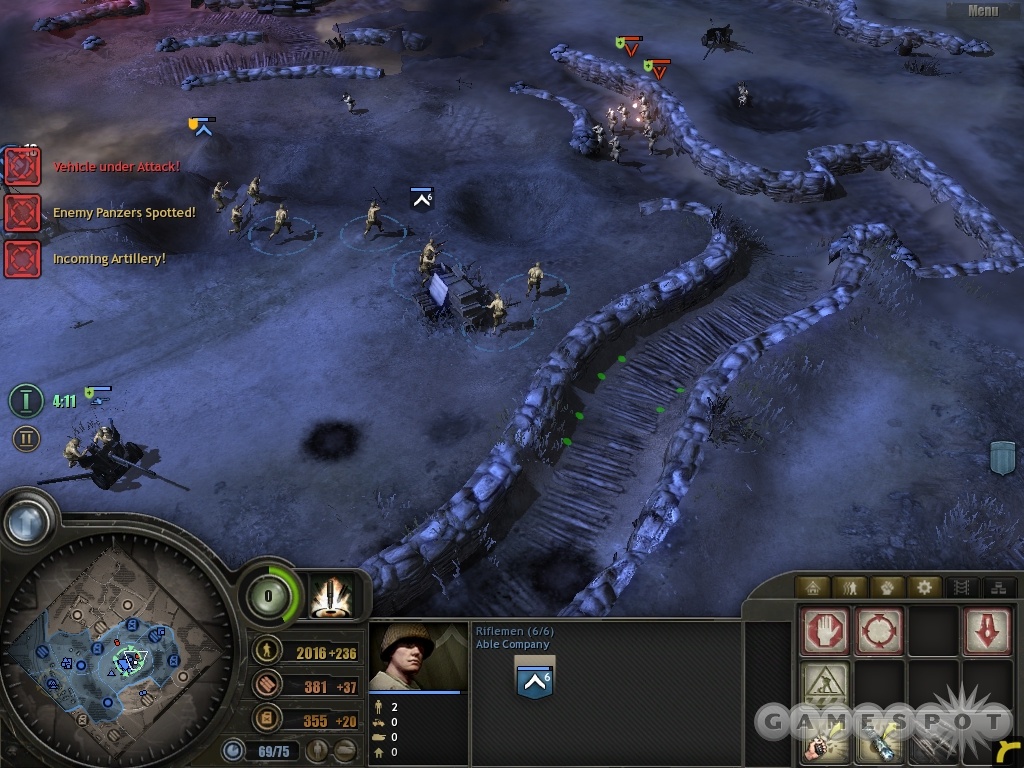
If you've played Relic's last real-time strategy game, Warhammer 40,000: Dawn of War, you'll note that many of these conventions were derived and extended from that game. However, Company of Heroes still plays quite differently from Dawn of War because of the nature of its densely packed battlefields and its even greater focus on unit tactics. You have some very interesting options to consider, such as how, when faced with an antitank gun manned by a squad of three, you may attempt to destroy the thing altogether with heavy weapons, or flank the gun and kill its squad, taking the artillery piece for your own. Heavy machine guns and other special weapons work much the same way. One of the great things about Company of Heroes is that, in spite of its somewhat glamorized portrayal of World War II, the game looks and behaves realistically, in how the sorts of tactical maneuvers that are central to the gameplay feel intuitive in practice. For example, you'll naturally want to avoid making your infantry rush a machine gun nest head-on, especially since the withering fire from a German MG42 will force your squad to drop prone, pinned down.
Relic's games have always featured clear step-by-step tutorials introducing you to many aspects of play, and Company of Heroes is no exception. However, you'll still have a lot to learn and much, much more to practice long after you've completed the tutorial and even the campaign. After all, the game gives you a great deal to think about and to manage during any given battle. You have to capture and hold resource points all across the map; build up your base, which doesn't take long since there are only a handful of structures; consider laying defenses like barbed wire, mines, machine gun nests, and roadblocks; micromanage any meaningful exchanges of fire since tactics are so important; and more. Company of Heroes features a cleanly presented interface that puts access to all your squads and production lines at your fingertips, but you'll still constantly feel like you need to be doing something more. Your squads can fend for themselves reasonably well in many cases, though the amount of micromanagement necessary to effectively manage your resources, resource and base defense, production, and combat will surely stretch your abilities thin. As a result, and thanks in part to the quality of the game's presentation, playing Company of Heroes can be a nerve-wracking experience.
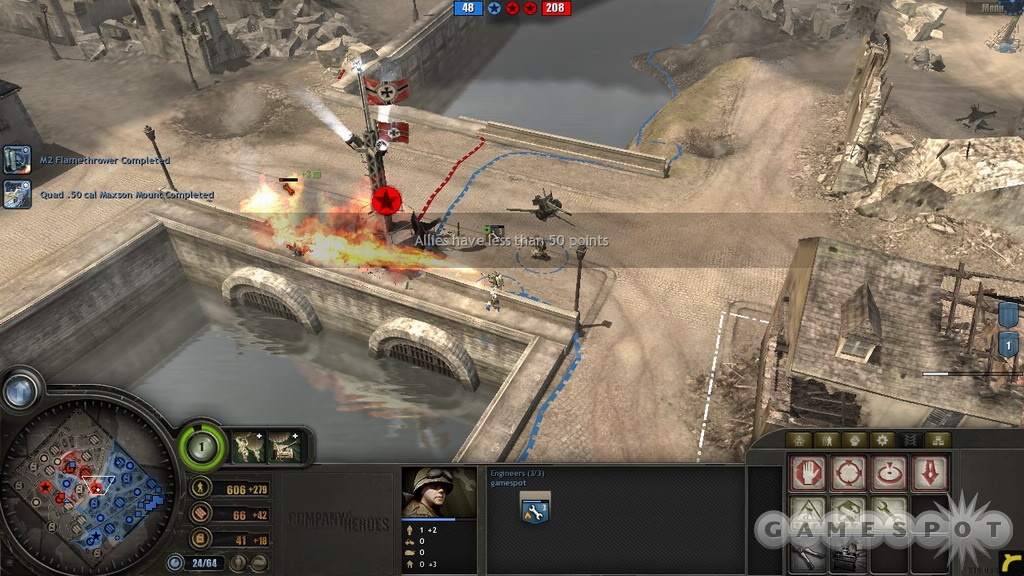
In fact, even very experienced RTS players will probably find that the campaign quickly gets rather challenging at the default difficulty setting. Both in the campaign and in skirmishes against the artificial intelligence, the opposition will relentlessly attack and attempt to recapture your resource points, will harass your main base, and will deploy mixed forces to attack your main armies, strategically retreating when necessary. The easy difficulty setting is a must for when you're still learning the ropes, though by teaming up with hard- or expert-level CPU opponents or watching replays of matches, you can start to figure out how the computer is playing so well. You may also issue orders while the game is paused during campaign and skirmish missions, if the game's single, rather fast speed setting feels too hectic.
Company of Heroes has some other interesting nuances, such as the company commander system, which lets you choose one of three different upgrade paths that reinforce your faction's core strengths. For example, the Allies' airborne path lets you send in paratroopers and call for support from P47 thunderbolt fighters high in the sky, while the Axis' blitzkrieg doctrine lets you deploy the Nazi army's fearsome storm troopers and devastating Tiger tanks. Such reinforcements come in quickly, foregoing traditional real-time strategy build times and letting you turn the tables on your opponent in a pinch, as long as you have enough resources. You rack up experience points as you fight, letting you invest in new technologies from whichever commander path you select. While the game prompts you to confirm your selection of a path, it's not like there's any time to reconsider their relative strengths in a fight. Thankfully, the campaign introduces you to the different paths on the Allied side, at least. Overall, the company commander system helps make up for the fact that there are only two factions to play with, since each commander path seems quite useful, and their weapons and upgrades will certainly come into play when you're deciding how to spend your resources. In total, the six paths also underscore different, viable strategies for both the Allies and the Axis, including different combinations of these paths for team battles.
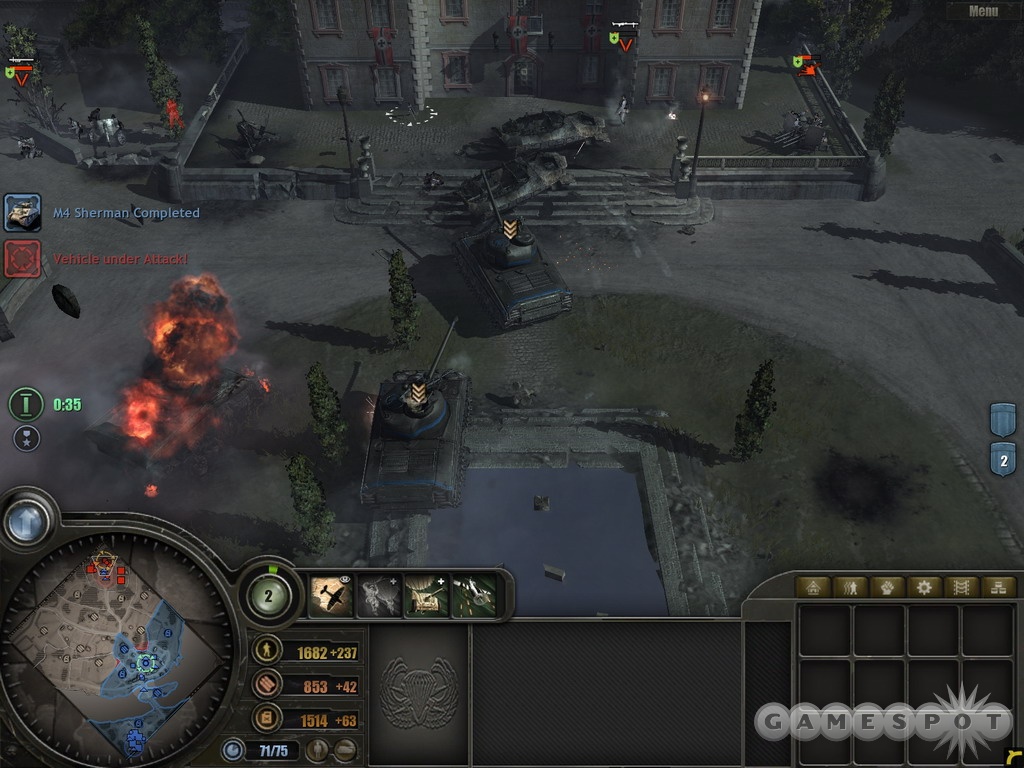
On top of all this, the typical match in Company of Heroes isn't all about simply blowing up the enemy's base, though "annihilation" victory conditions are an option for skirmish and multiplayer matches. However, the default option puts you in a tug-of-war battle to capture and hold a set of victory points. The more points you control, the faster you achieve victory. But victory points tend to be centrally located, and unlike other resource nodes, they can't be fortified with observation posts to defend them against capture. So combat will naturally be concentrated around these locations, though that's not to say the opponent's base won't make a key target of opportunity, either. Essentially, what Company of Heroes' resource model and victory points system does is force you to think about the entire map, not just your base and the enemy's base. This makes battles more interesting but more complicated, and even though a typical skirmish may last close to an hour, the time just seems to fly by since there's so much to do. The victory point system also addresses a common RTS design flaw by offsetting the unlimited supply of resources on each map and therefore virtually eliminating the possibility of a stalemate.
The truly amazing visuals in Company of Heroes demand a top-of-the-line system and a cutting-edge graphics card to get the most out of them. Even on a machine meeting the game's steep recommended system requirements, the action can still bog down in a few spots when explosions and bodies are landing everwhere, and loading times between matches can be about a minute long. Also, a bug in the shipping version of the game caused systems with an SLI video card configuration to experience inordinately poor frame rates, which we resolved simply by unplugging one of our cards. On more-modest systems, you can strip away a lot of the detail to improve the game's performance, but seeing the game in all its glory is truly a sight to behold--especially its various types of explosions that fill the screen with fire, smoke, and debris. The default camera perspective is optimal for gameplay, but you can zoom right in to clearly see each individual soldier and his gear, or how a tank, turning a tight corner through a city street, might take a chunk right out of the side of a building. This level of visual fidelity far exceeds what's previously been done in a strategy game, and is much closer to what you might find in a flashy new first-person shooter. But it's not just for show, since the graphics' realism helps make the gameplay itself more engrossing and intuitive. The game also includes some surprisingly gory displays on occasion; an artillery shell, for instance, can tear men into pieces. However, there isn't nearly as much blood and gore as in something like Saving Private Ryan, so the game's M for Mature rating seems more fitting due to infantry's liberal use of profanity during combat. Unfortunately for those preferring and accustomed to a tamer version of World War II, you can't simply toggle off the strong language.
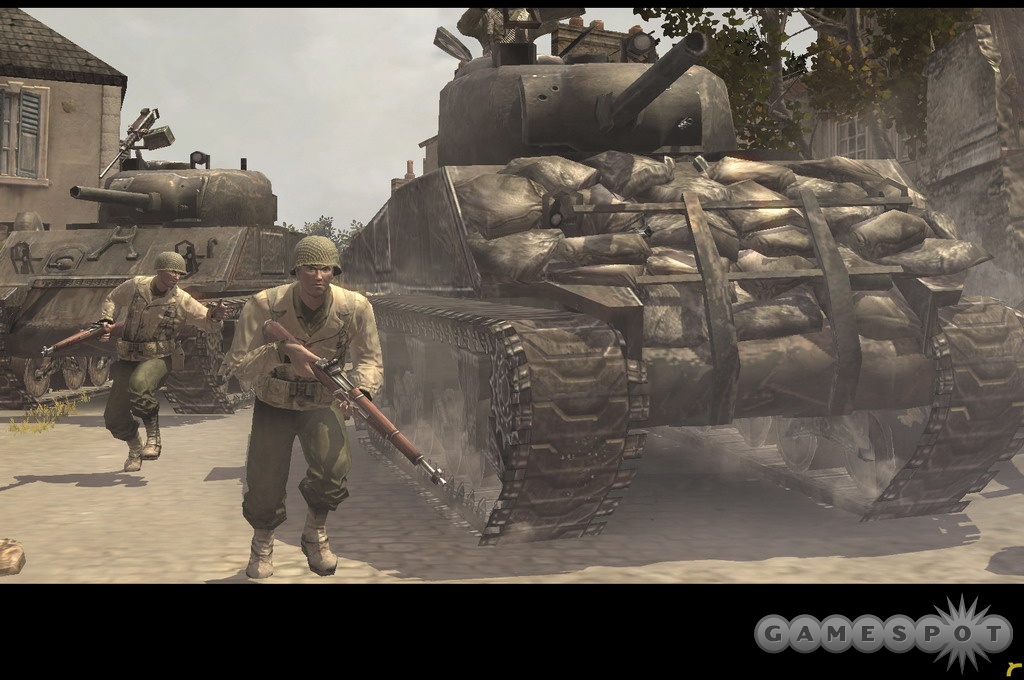
The audio in Company of Heroes is fantastic, and just about the only less-than-perfect thing about it is how units will cut themselves off repeatedly while trying to acknowledge your orders as you rapidly click around, micromanaging their movement in battle. However, the game makes excellent and subtle use of speech for the most part, such as how your units will acknowledge you in a hushed whisper during nighttime operations, how you can hear the panic in the voices of your tank commanders when their vehicles are badly damaged, or how speech coming from offscreen units sounds like it's coming in over a radio. The sound effects for gunfire, cannons, and other weapons on the battlefield are loud and clear, and the hornet's buzzing of machine gun fire or the thunderous crack of a tank's main gun never cease to be particularly intense. Company of Heroes also features an excellent symphonic score that's filled with foreboding strings and brass, just like you'd expect from a WWII game--or a WWII movie. The way it seamlessly blends with how the action unfolds makes the latter comparison more fitting.
Company of Heroes is technically remarkable and features some novel twists that make it unique among real-time strategy games. Yet while it's easy to get into, it's not just difficult to master but also rather difficult to manage, partly because the game does such a good job of evoking the sheer chaos of frontline WWII battles. The relatively small number of units spread across the two playable factions also means that this game doesn't have the sheer variety you might expect from an RTS, though the units themselves seem much more realistic and interesting than in most such games. In spite of these issues, remarkably, Company of Heroes still stands out from the glut of WWII-themed games released over the years, as well as the glut of real-time strategy games.
Editor's note 09/13/06: GameSpot learned after this review was originally posted that the sluggish performance we experienced while testing Company of Heroes on our primary high-end system was due to a specific bug in the shipping version of the game, relating to SLI graphics cards configurations. When we resolved this rare issue, we experienced substantially improved performance. As a result, we have updated portions of this review to more accurately reflect the game's overall performance and quality.